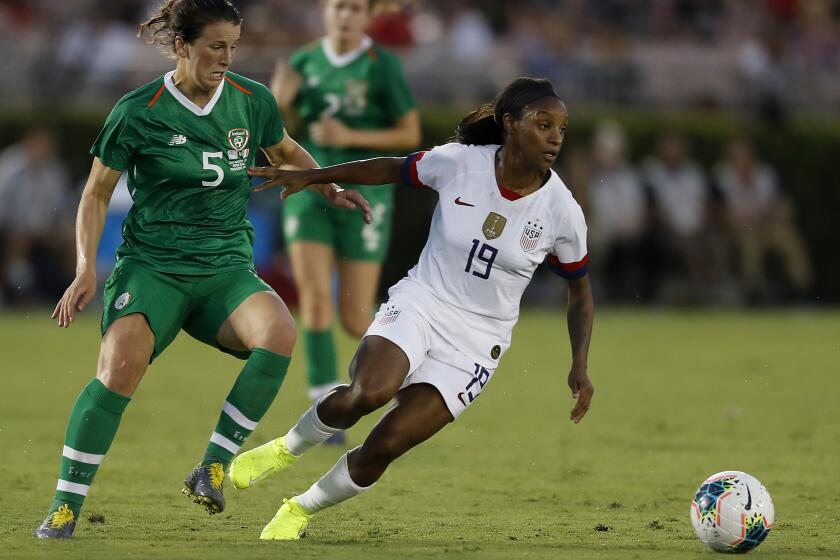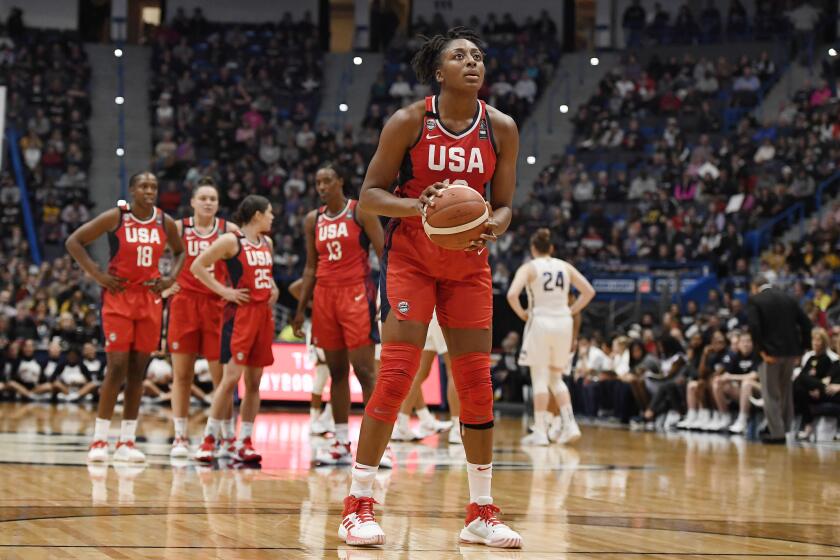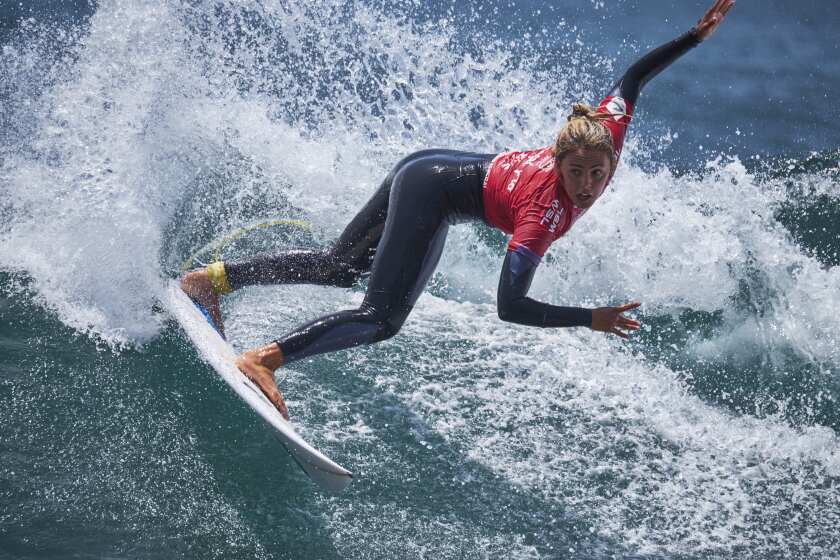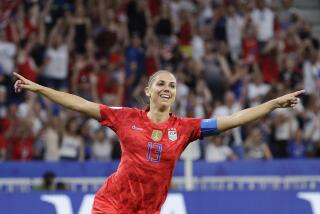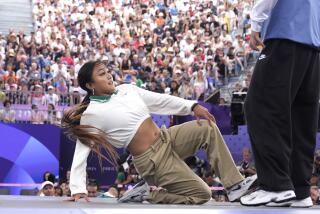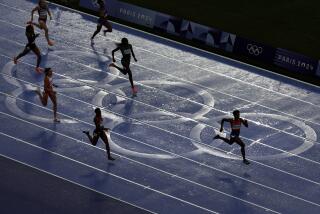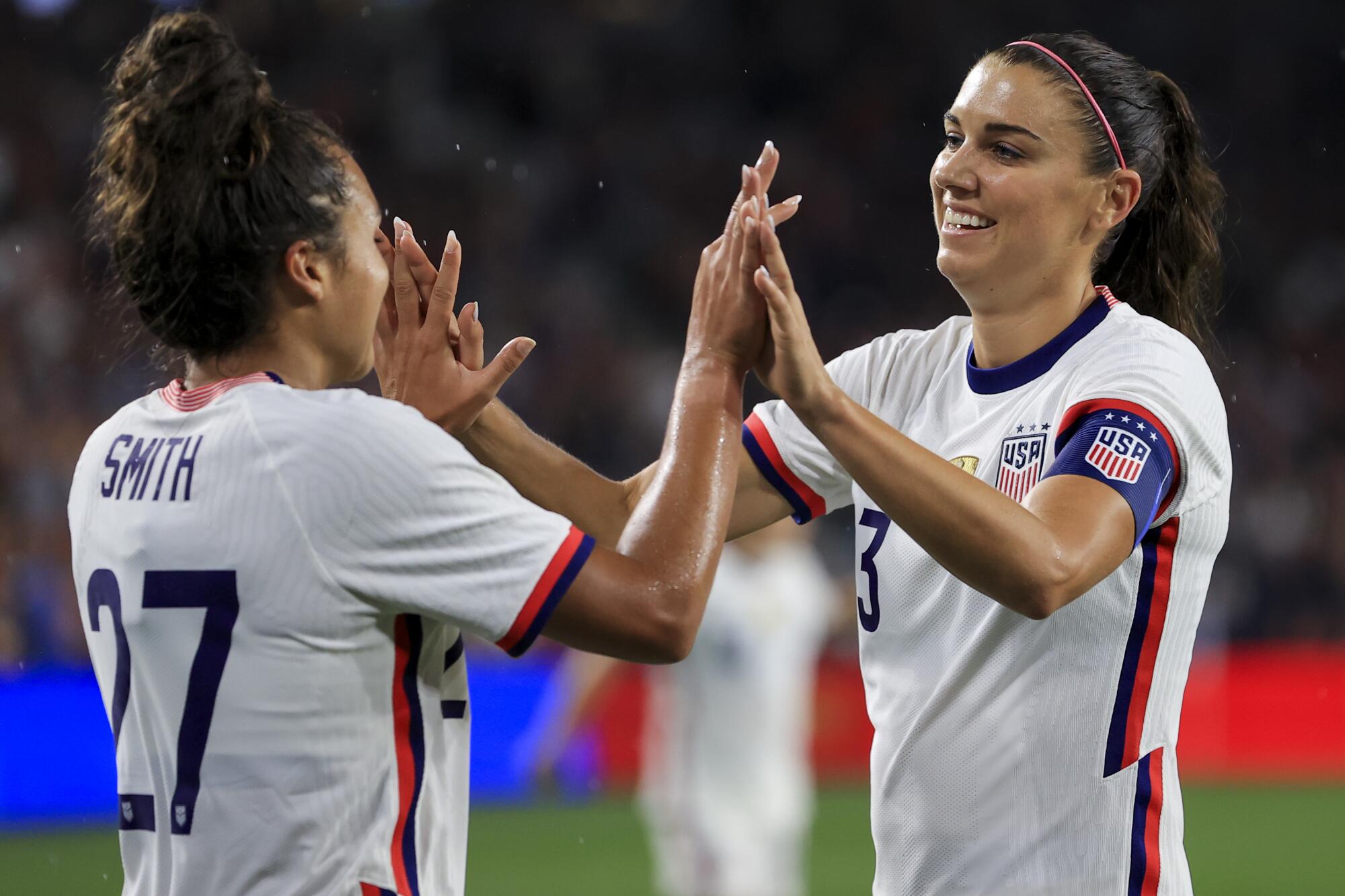
- Share via
Twitter was fairly new when Alex Morgan — still a college student, not quite famous yet — gave it a try around 2009. Soon, Instagram came along and she began posting there too.
“I went into social media a little more innocent,” she says. “It was just fun.”
As the years passed, as Morgan graduated from playing soccer at UC Berkeley to the U.S. women’s team, winning World Cups and Olympic medals, she started mixing business with pleasure.
Like a lot of female athletes, the San Dimas native realized her sport had hit a roadblock, too often ignored by mainstream newspapers, magazines and television. She saw a way around the problem.
Social media helped her promote women’s soccer by connecting her directly with fans and telling her story. Her following grew to 9.5 million, making her attractive to corporate sponsors because — on Instagram, at least — she was three times more popular than the Dodgers.
“I don’t have the salary of a Ronaldo or Messi,” says Morgan, now with San Diego Wave of the NWSL. “I think females have been able to use their platforms to gain more financial viability.”
This week marks 50 years since the enactment of Title IX, a groundbreaking law that prohibits sex discrimination in all programs or activities at federally funded schools. Its anniversary has prompted lots of talk about numbers — the continued growth of sports participation among women and girls, increased funding for their high school and college teams, the gap with boys and men that still needs work.
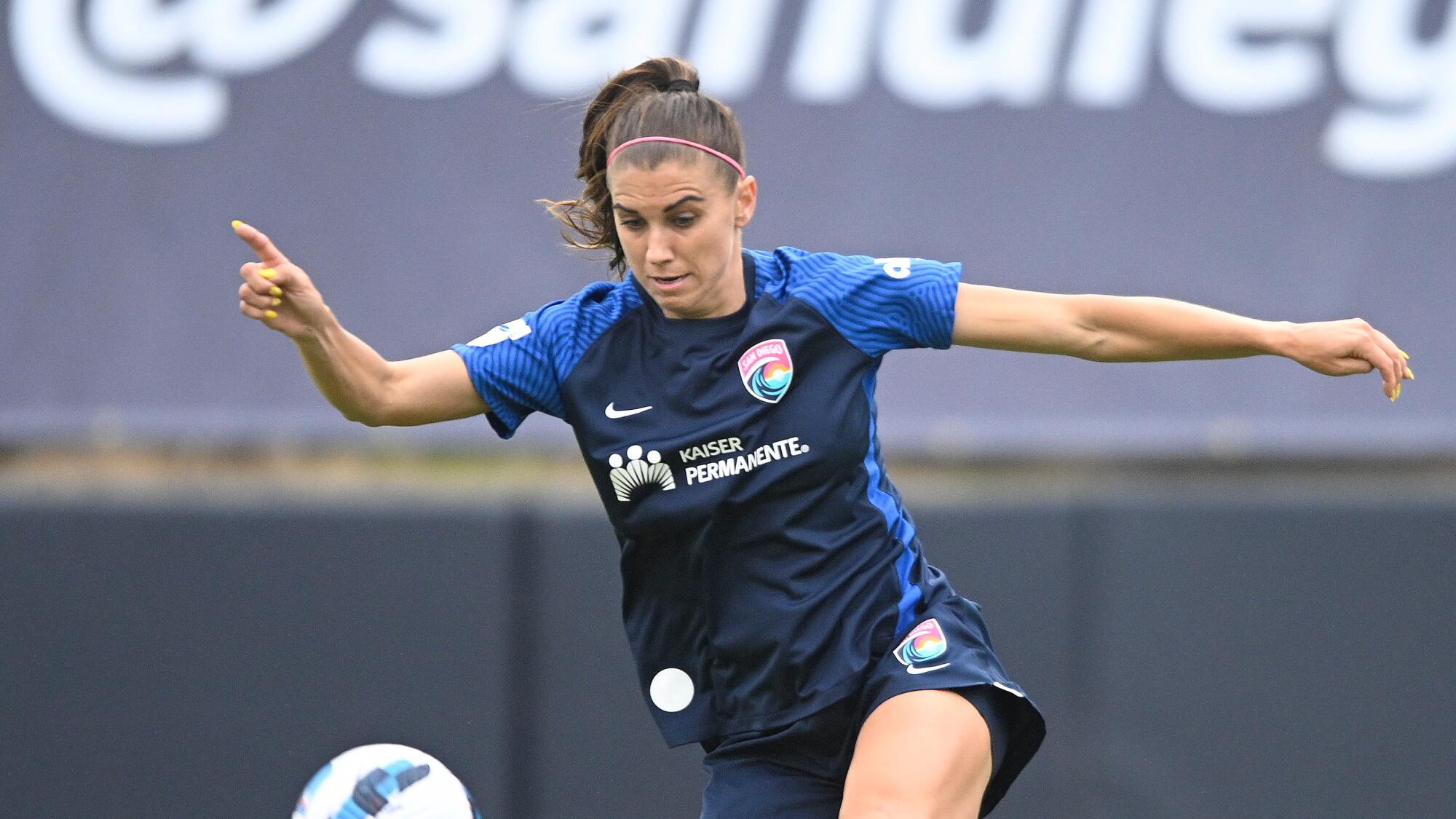
Just beyond the law’s jurisdiction hovers another element of the story, as female athletes continue to struggle for attention.
A decades-long study by USC and Purdue found that women accounted for only 5% of the highlights shown on nightly news, ESPN’s “SportsCenter” and other broadcasts. Research has noted similar discrepancies in print and digital news.
“Men’s sports — especially the ‘Big Three’ of basketball, football and baseball — still receive the lion’s share of the coverage, whether in-season or out of season,” the USC-Purdue study noted. “When a women’s sports story does appear, it is usually a case of ‘one and done,’ a single women’s sports story obscured by a cluster of men’s stories.”
Crystal Dunn and Alex Morgan are among the latest wave of U.S. Women’s National Team soccer players who are juggling their careers and motherhood.
Female athletes have yet to rival the social media outreach of Cristiano Ronaldo at 455 million Instagram followers or LeBron James at 124 million, but Serena Williams has built a following of 14.9 million and Simone Biles has 6.8 million. Years after she retired from tennis, Maria Sharapova still has 8.4 million followers on Twitter.
“Women athletes have needed to be more creative,” says Cheryl Cooky, an American Studies professor at Purdue. “When social media popped up and there was a shift in the media landscape, where content can be produced by anyone, that gave them more power.”
In the spring of 2021, a Stanford performance coach posted Instagram photos of the disparity between the men’s and women’s weight rooms during March Madness. Oregon basketball player Sedona Prince followed with a TikTok video that went viral.
“If you aren’t upset about this problem, then you’re a part of it,” Prince told her 3.1 million followers.
The NCAA responded with an apology and a quick upgrade.
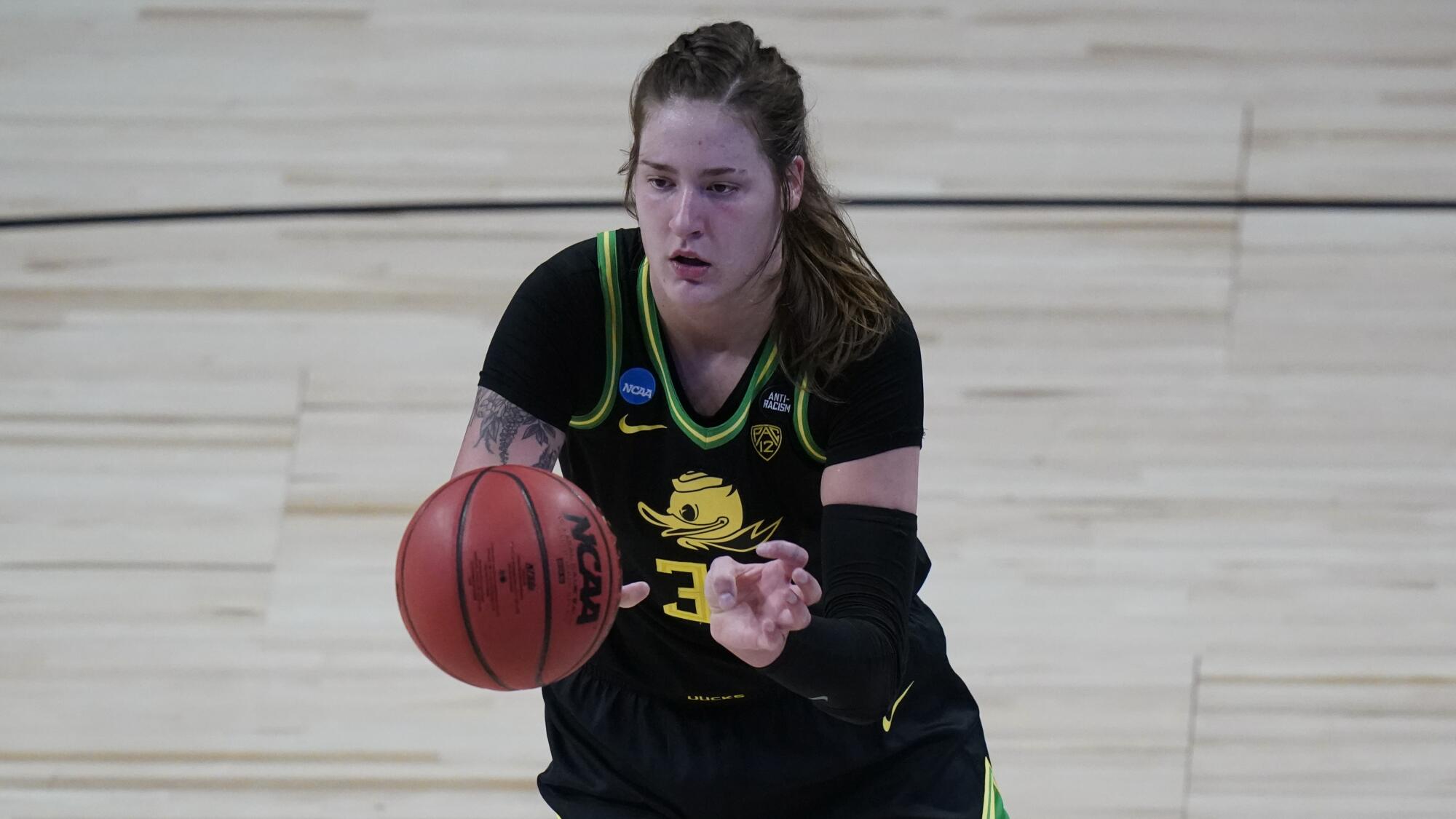
The incident drew attention to a trend years in the making — female athletes had become adept at marketing themselves and their sports through images that ranged from carefully planned to informal and personal.
Williams shares photographs of hanging out with Kim Kardashian and Kendall Jenner at an Oscars afterparty. Biles posts snapshots of going to a Houston Astros game with her fiancé, Houston Texans safety Jonathan Owens. Soccer player Ali Krieger, a teammate of Morgan’s on the national squad, shows pictures with her daughter, Sloane.
Tracking “likes” and talking with fans helped Krieger, who plays for Gotham FC in the NWSL, identify which kinds of posts resonated most.
“People are wanting you to share a little bit more because that is how they connect,” she says. “They don’t just connect through football; they actually connect through your personal life and your stories.”
Social media serve a slightly different role for Liz Cambage, who has secured a place in the fashion world and was featured in an ad campaign for French designer Thierry Mugler. The 6-foot-9 Sparks center calls posting and tagging photos of herself in stylish outfits “a second business for me.”
“It’s part of being an athlete now,” she says. “Some people don’t like it.”
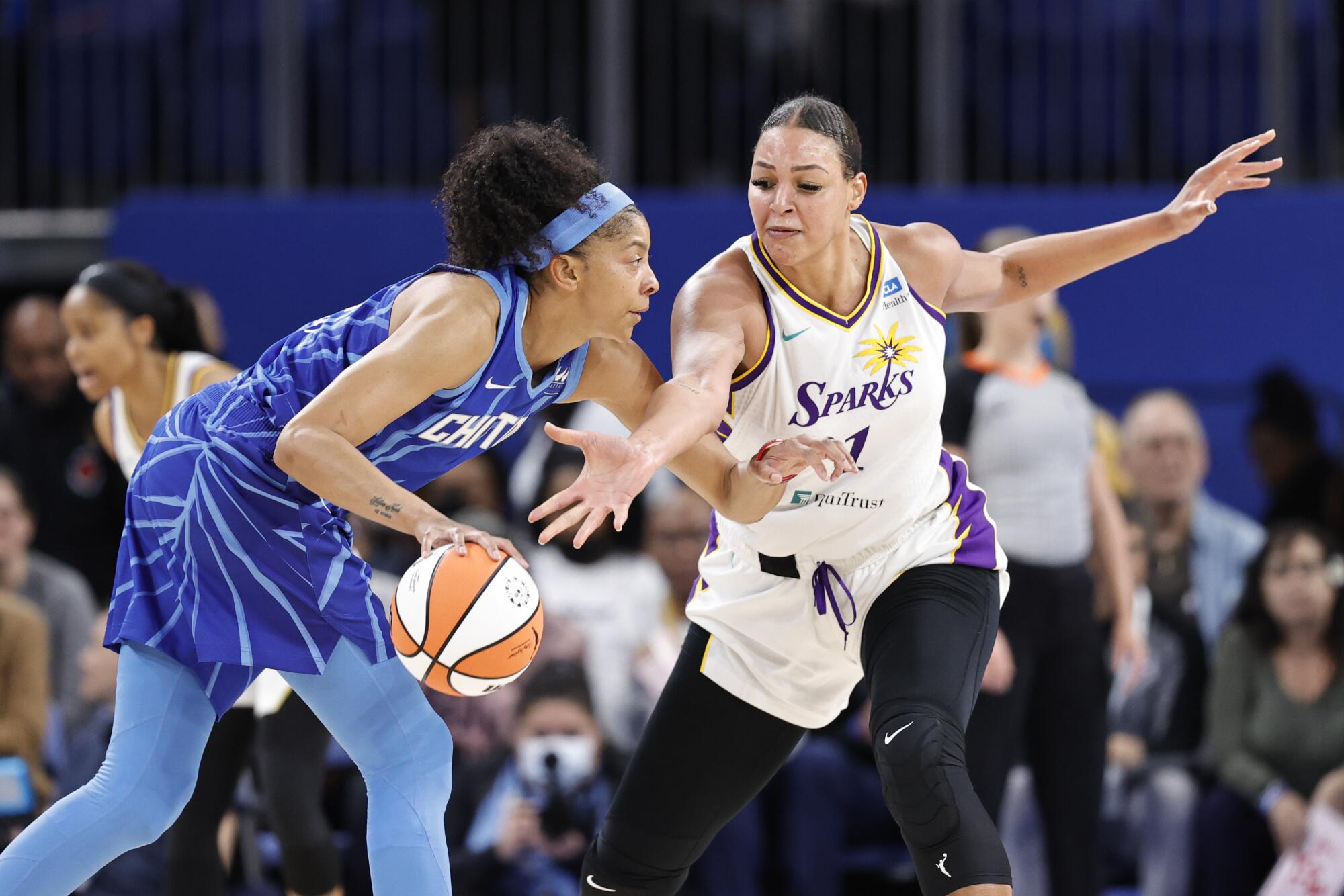
Exposure is crucial for women who may not get as many commercial opportunities as their male counterparts. Even Williams, a familiar face on television, populates her account with posts for a migraine medication and a video of herself in the kitchen, cooking with a sponsor’s plant-based eggs.
As one of the most-famous soccer players in the U.S. — male or female — Morgan highlights a mattress company and a sports drink she endorses, saying; “For a lot of sponsors, it’s a numbers game. They’re looking at followers and analytics and reaction to sponsored posts.”
But self-marketing can raise difficult questions. Hanna and Haley Cavinder, twins who play college basketball at Miami, have attracted 4 million followers and a string of lucrative NIL deals with a TikTok account that features them dancing in bikinis and tight dresses.
“There is still this expectation to conform to a particular kind of image or create a particular brand,” Cooky says. “It might fall into a trap, the conventional notions of femininity or beauty or heteronormative roles.”
You’ve seen them compete, these living breathing embodiments of strength and skill and athleticism. They’re women in sports, some of them trail blazers; others, members of a new generation of athletes.
Through the 1980s and ‘90s, research shows, media tended to trivialize female athletes by portraying them in sexy outfits or writing about them as wives and girlfriends. The situation has improved but remains a concern. Cambage talks about the archetypal “Instagram girl, pretty girl, lashes all the time, wearing cute clothes.”
“It’s sad that me buying into that helped propel my marketability,” she says. “I think that’s more of a reflection of the world we live in.”
Some athletes insist on sticking to everyday content. Family life, lunch dates, vacations. This approach has been valuable to Krieger who, for years, remained publicly quiet about her relationship with teammate Ashlyn Harris. As members on the U.S. roster, they worried about pushback.
“We weren’t sure how our sponsors or our team were going to react,” she says. “You have to understand that if you take this risk, you could possibly lose your job.”
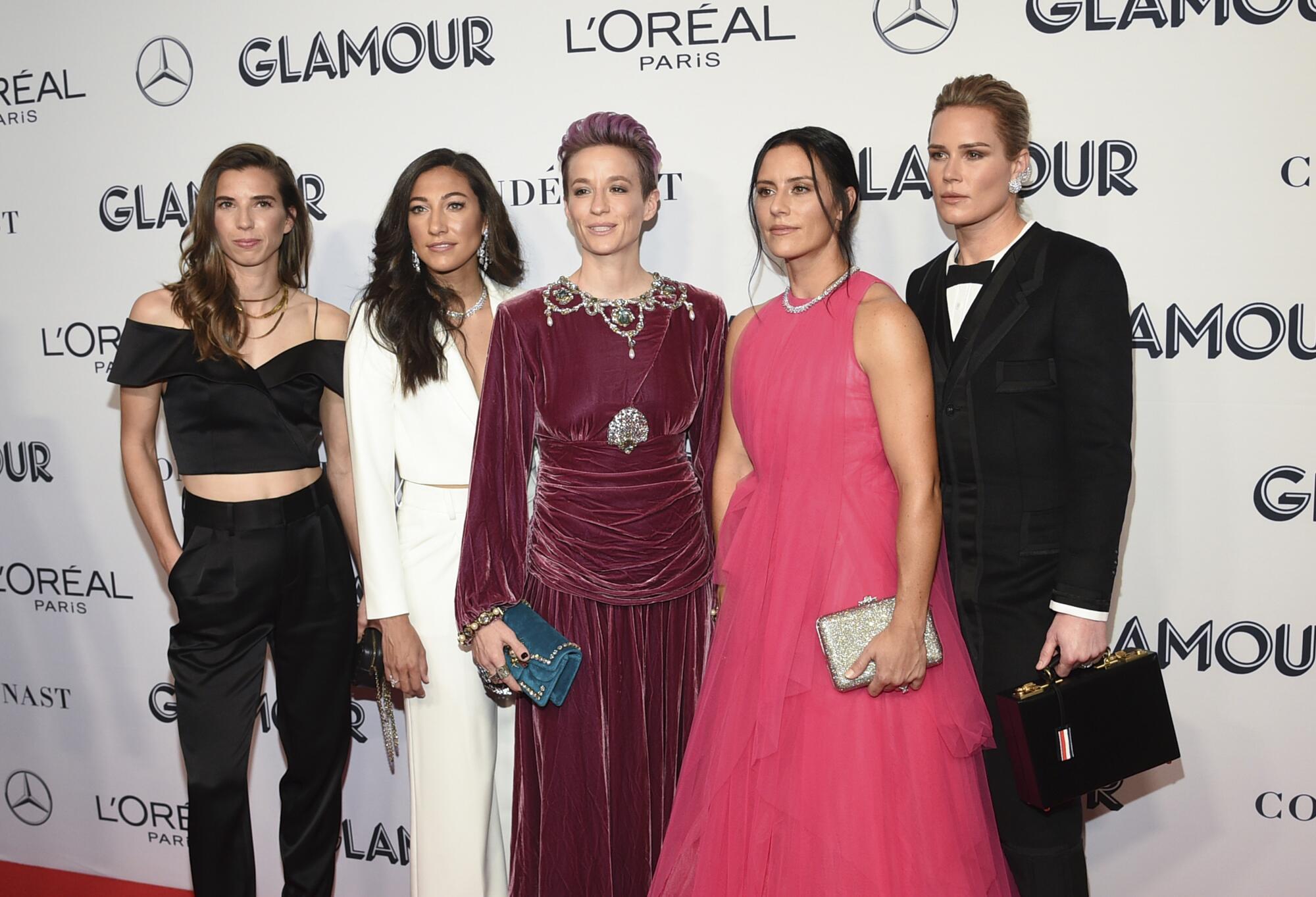
The couple decided to chronicle their 2019 wedding on Instagram. Predictably nasty comments were overshadowed by thousands of congratulations and an enthusiastic response from sponsors.
“The support we got was incredible,” Krieger says. “I never thought in a million years.”
The presence of female athletes on social media has helped fuel broader efforts such as the Athletes Unlimited sports leagues and “Just Women’s Sports, a website that has reported continued audience growth. Cooky sees the continuation of an alternative route to success.
“You have to cultivate an audience,” the professor says. “You have to build a market.”
Not that legacy media are entirely out of the picture.
The 24-hour television channel will be entirely devoted to covering female athletes.
A 2018 Nielsen poll found that 66% of the population and 84% of fans in the U.S., western Europe, Australia and New Zealand expressed interest in at least one women’s sport. A recent report from Deloitte, the accounting and consulting giant, predicted that more television and print attention could trigger a breakthrough for women.
But female athletes aren’t waiting around.
“Building a brand is very difficult,” Krieger says. “You have to be strategic.”
For women who have learned to use social media, that means staying diligent and resourceful. It means they’ll keep doing the work themselves.
Times staff writer Myah Taylor contributed to this report.
More to Read
Go beyond the scoreboard
Get the latest on L.A.'s teams in the daily Sports Report newsletter.
You may occasionally receive promotional content from the Los Angeles Times.

